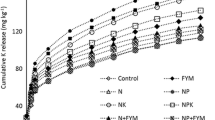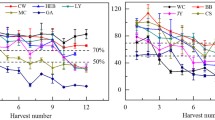Summary
Ammonium acetate extractable potassium in the soil reached a minimum value of 6.8 mg K/100g soil after 14 crops of wheat and pearl millet in the field without applying any potassium fertilizer. At this level of ammonium acetate extractable K both wheat and pearl millet utilized about, 90 per cent of the total K from non-exchangeable sources. Wheat and pearl millet were grown in this soil in the greenhouse at different levels of K. At K0 level wheat utilized 86 per cent of the total K uptake from the non-exchangeable source and pearl millet, 95 per cent. At K1 level, wheat utilized only 19 per cent but at higher levels of K, there was build up in the K status of soils. In the case of pearl millet at K1, K2 and K3 levels 59, 13 and 22 per cent of total uptake were contributed by non-exchangeable forms. The total K uptake by pearl millet was more than double that by wheat. Plant analysis showed that 83 per cent of the total K in wheat was contained in the shoot portion and the rest in the roots. The corresponding figures for pearl millet were 94 and 6 per cent.
Similar content being viewed by others
References
Thomas Frank H and Giddens Joel E 1958 Release of non-exchangeable Na and K to exchangeable forms. Soil Sci. 85, pages
Hoagland D R and Martin J C 1933 Absorption of plants in relation to replaceable, non-replaceable and soil solution potassium. Soil Sci. 36, 1–33.
McLean E O 1978 Influence of K content and clay composition on potassium availability.In Potassium in Soils and Crops: Potash Research Institute of India, New Delhi 1978.
McLean E O and Simon R H 1958 Potassium release and fixation in Ohio soils as measured by cropping and chemical fixation. Research Bull. No. 824, Ohio AES.
Mehta B V 1976 Potassium status of Gujarat Soils. Ind. Soc. Soil Sci. Bull No. 10, 25.
Piper C S 1967 Soil and Plant Analysis. Asia Publishing House, Bombay.
Pratt P F 1965 Potassium, Agronomy 9, 1022–30.
Ramanathan K M 1977 Studies on Dynamics of Soil Potassium. Ph. D. Thesis, Tamil Nadu Agri. Univ. Coimbatore.
Reitemeier R F 1951. Soil Potassium. Advances in Agronomy, Vol. 3.
Russell E W 1973 Soil Condition and Plant Growth. 10th, Edn. The English Language Book Society of Zargeans. London, 614 p.
Tabatabai M A and Harway J J 1969 Potassium supplying power of Iowa soils at their minimal level, of exchangeable potassium. Proc. Soil Sci. Soc. Am. 33, 105–09.
Thomas G W 1967 Problems encountered in soil testing methods.In Soil Testing and Plant Analysis, Part No. 2. Soil Sci. Soc. Am. Madison, Wis. pp 37–53.
Author information
Authors and Affiliations
Rights and permissions
About this article
Cite this article
Krishnakumari, M., Khera, M.S. & Ghosh, A.B. Studies on potassium release in an inceptisol soil (Holambi Series) at the minimum level of exchangeable potassium. Plant Soil 79, 3–10 (1984). https://doi.org/10.1007/BF02182139
Received:
Revised:
Issue Date:
DOI: https://doi.org/10.1007/BF02182139




